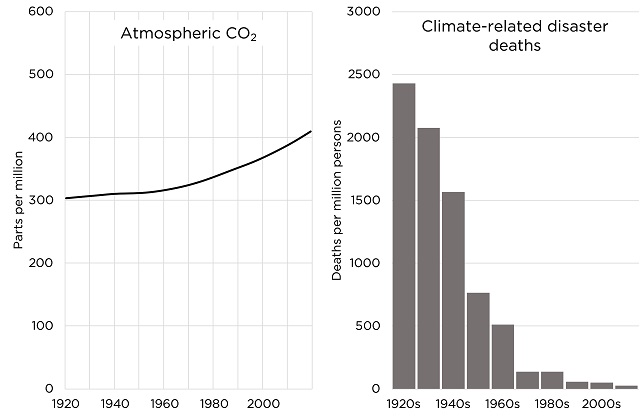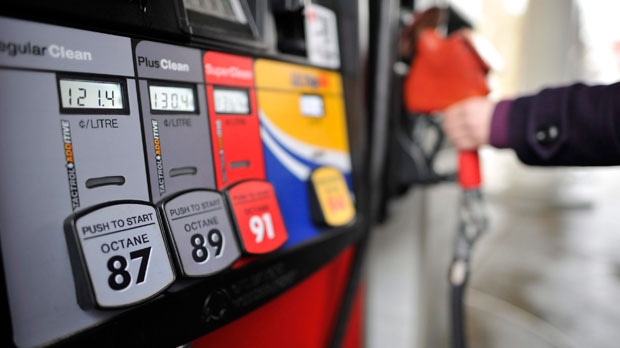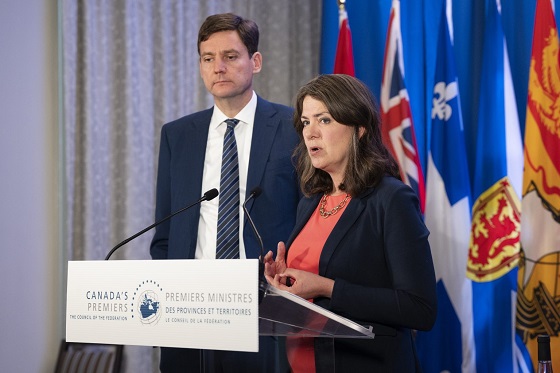Economy
Climate researchers show we’re actually “safer than ever from climate” catastrophes

The climate safety denial movement
I and others have documented that we’re safer than ever from climate. Catastrophists can’t refute us, so they’re now saying that disaster deaths don’t matter!
|
|
For decades climate catastrophists have portrayed climate disasters as getting deadlier and deadlier.
Now that I and others have documented that we’re safer than ever from climate, catastrophists are saying that disaster deaths don’t matter!
- Reuters says “Drop in climate-related disaster deaths not evidence against climate emergency.”
But a drop in deaths from something—here, a 98% drop—is obvious evidence against it being an emergency.
Would Reuters say: “98% drop in flu deaths not evidence against flu emergency”?¹
- Why is Reuters, along with The New York Times, PolitiFact, and USA Today, claiming that a 98% drop in climate disaster deaths doesn’t contradict their climate emergency narrative? Because it obviously does, and they can only save their narrative by intimidating us into denying the obvious.²
- The central narrative of climate catastrophists is that fossil fuels and their CO2 emissions are killing more and more people via climate disasters.
This narrative has always had a fatal weakness: it totally contradicts the data, which show plummeting climate disaster deaths.³
- Why are climate disaster deaths plummeting as fossil fuel use and CO2 emissions rise?
Because the enormous ability uniquely cost-effective and scalable fossil fuel energy gives us to master climate danger far outweighs any new climate challenges from CO2 emissions.
- An example of fossil-fueled climate mastery overwhelming CO2 impacts is drought.
Any contribution of rising CO2 to drought has been overwhelmed by fossil-fueled irrigation and crop transport, which have helped reduce drought deaths by over 100 times over 100 years as CO2 levels have risen.⁴
- Over the last decade, I and a number of others, including Bjorn Lomborg and Michael Shellenberger, have challenged catastrophism by pointing to declining climate disaster deaths.
Catastrophists couldn’t refute our argument. So instead they pretended it didn’t exist.
Until last year.⁵
- In 2023, climate catastrophists finally felt compelled to address the fact that climate disaster deaths have plummeted (driven by fossil-fueled climate mastery).
Because of honesty? No—because Presidential candidates started bringing it up and persuading people with it.
- Here is Vivek Ramaswamy during his Presidential campaign referring to a 98% decline in climate disaster deaths—and, crucially, giving fossil fuel energy credit.
- Here is Ron DeSantis during his Presidential campaign referring to a 98% decline in climate disaster deaths—and, crucially, giving fossil fuel energy credit.
- The 98% decline in climate disaster deaths, driven by fossil fuels, is a blockbuster fact: it shows that we are experiencing not fossil-fueled climate emergency but fossil-fueled climate safety.
But instead of being happy, catastrophists engage in climate safety denial.
- Here are 3 recent instances of climate safety denial—from Reuters, PolitiFact, and USA Today. All have long portrayed climate deaths as a fast-increasing problem. But now they claim deaths don’t matter.
https://www.reuters.com/fact-check/drop-climate-related- disaster-deaths-not-evidence- against-climate-emergency- 2023-09-19/ - Climate safety denial utilizes 5 main myths to evade the decline in disaster deaths:
1. Fossil fuels don’t deserve credit
2. Weather forecasting deserves the credit
3. 100 years is a misleading period
4. Damages are drastically increasing
5. There’s a major increase in reported disasters - Myth 1: Fossil fuels don’t deserve much credit for plummeting climate disaster deaths; it’s “resilience.”
Truth: Uniquely cost-effective and scalable fossil fuel energy makes us resilient through plentiful infrastructure-building, heating and cooling, irrigation, transportation, etc.⁶
- Myth 2: Storm warning systems deserve the credit for plummeting climate disaster deaths.
Truth: Drought, not storm, deaths are the leading source of reduced climate deaths. And fossil fuels power storm warning and evacuation systems (and more resilient infrastructure).⁷
- Myth 3: 100 years is a misleading period to measure plummeting climate disaster deaths.
Truth: 100 years is a standard, very meaningful period to look at. While we have data going back an additional two decades, those tend to underreport due to less global communication.⁸
- Contrary to the claim that starting analysis of climate disaster deaths in the 1920s overestimates the decline, it actually likely underestimates the decline due to insufficient past reporting; data before WWII extremely likely underreport deaths compared to data after 2000.
- Myth 4: There is an alarming increase in reported disasters, revealing an underlying climate emergency.
Truth: The increase in reported disasters over time is due overwhelmingly to increased global communication. Changes in fundamentals, such as storms, are extremely modest.⁹
- The claim that more reported disasters show an increasingly dangerous climate is absurd in light of the fact that underlying data show massive increases in reporting before significant human climate impacts and the reporting trend also massively goes up for non-climate causes!
- Other biases might inflate the number of reported disasters. E.g., governments of poor countries have an incentive to declare more disasters with increasing international relief.¹⁰
- Using obviously problematic disaster frequency reporting instead of direct climatological evidence to try and show increasing climate danger is a revealing choice by catastrophists. They are making it because the climate change we’ve experienced has been very modest—and masterable.
Do Not Declare a “Climate Emergency”
·AUGUST 17, 2023Read full story - An example of unalarming climate fundamentals: neither the frequency nor the energy in global hurricanes has changed significantly relative to the noisy average. There is also little evidence for more landfalling hurricanes.¹¹
- The catastrophist attempt to undermine the 98% decrease in disaster deaths by pointing to the increased reporting of disasters is actually self-defeating.
If disaster deaths are plummeting despite incomplete past reporting, that means they’ve declined by even more than 98%.
- Myth 5: Climate damages are drastically increasing, revealing an underlying climate emergency.
Truth: Even though there are many incentives for climate damages to go up—preferences for riskier areas, government bailouts—GDP-adjusted damages are flat.¹²
- We often hear that “billion-dollar disasters” have increased significantly. But this is a bogus metric. Of course, as GDP grows we’ll have more billion-dollar disasters because there is more wealth for disasters to strike. But when we adjust for GDP there’s no increase in damage.¹³
- A Reuters “fact check” alarmingly claims a 151% growth in disaster damages from a period starting in 1978 to a period ending in 2017.
But they evade that the global economy grew by over 200% during that period!
(And they evade that disaster and damage reporting increased.)¹⁴
- The stupidest climate safety denial myth (used by The New York Times): 2 million people died from extreme weather in the last 50 years; that’s obviously an emergency.
Truth: 2 million in 50 years is a rate of 40,000 per year—far, far less than 100 years ago, thus confirming today’s climate safety.¹⁵
- The last-gasp climate safety denial myth: Okay, we’re safer than ever from climate disasters, and it is driven by cheap energy from fossil fuels, but we can easily replace fossil fuels with solar and wind.
Truth: For the foreseeable future there is no cheap global energy without fossil fuels.
The ultimate debunking of “solar and wind are cheaper than fossil fuels.”
·JULY 19, 2023Read full story - Observe that all these seemingly scientific outlets, such as The New York Times, Reuters, and PolitiFact are totally unable to refute the death-blow to their “climate emergency” narrative that is the drastic decline in climate disaster deaths.
Science requires that they admit defeat.
Popular links
- EnergyTalkingPoints.com: Hundreds of concise, powerful, well-referenced talking points on energy, environmental, and climate issues.
- My new book Fossil Future: Why Global Human Flourishing Requires More Oil, Coal, and Natural Gas—Not Less.
- Speaking and media inquiries.
“Energy Talking Points by Alex Epstein” is my free Substack newsletter designed to give as many people as possible access to concise, powerful, well-referenced talking points on the latest energy, environmental, and climate issues from a pro-human, pro-energy perspective.
Share Energy Talking Points by Alex Epstein
UC San Diego – The Keeling Curve
For every million people on earth, annual deaths from climate-related causes (extreme temperature, drought, flood, storms, wildfires) declined 98%–from an average of 247 per year during the 1920s to 2.5 per year during the 2010s.
Data on disaster deaths come from EM-DAT, CRED / UCLouvain, Brussels, Belgium – www.emdat.be (D. Guha-Sapir).
Population estimates for the 1920s from the Maddison Database 2010, the Groningen Growth and Development Centre, Faculty of Economics and Business at University of Groningen. For years not shown, population is assumed to have grown at a steady rate.
Population estimates for the 2010s come from World Bank Data
Business
Canadians love Nordic-style social programs as long as someone else pays for them

This article supplied by Troy Media.
 By Pat Murphy
By Pat Murphy
Generous social programs come with trade-offs. Pretending otherwise is political fiction
Nordic societies fund their own benefits through taxes and cost-sharing. Canadians expect someone to foot the bill
Like Donald Trump, one of my favourite words starts with the letter “T.” But where Trump likes the word “tariff,” my choice is “trade-off.” Virtually everything in life is a trade-off, and we’d all be much better off if we instinctively understood that.
Think about it.
If you yield to the immediate pleasure of spending all your money on whatever catches your fancy, you’ll wind up broke. If you regularly enjoy drinking to excess, be prepared to pay the unpleasant price of hangovers and maybe worse. If you don’t bother to acquire some marketable skill or credential, don’t be surprised if your employment prospects are limited. If you succumb to the allure of fooling around, you may well lose your marriage. And so on.
Failing to understand trade-offs also extends into political life. Take, for instance, the current fashion for anti-capitalist democratic socialism. Pushed to explain their vision, proponents will often make reference to the Nordic countries. But they exhibit little or no understanding of how these societies actually work.
As American economist Deirdre Nansen McCloskey notes, “Sweden is pretty much as ‘capitalistic’ as is the United States. If ‘socialism’ means government ownership of the means of production, which is the classic definition, Sweden never qualified.” The central planning/government ownership model isn’t the Swedish way.
What the Nordics do have, however, is a robust social safety net. And it’s useful to look at how they pay for it.
J.P. Morgan’s Michael Cembalest is a man who knows his way around data. He puts it this way: “Copy the Nordic model if you like, but understand that it entails a lot of capitalism and pro-business policies, a lot of taxation on middle-class spending and wages, minimal reliance on corporate taxation and plenty of co-pays and deductibles in its health care system.”
For instance, take the kind of taxes that are often derided as undesirably regressive—sales taxes, social security taxes and payroll taxes. In Sweden, they account for a whopping 27 per cent of gross domestic product. And some 15 per cent of health expenditures are out of pocket.
Charles Lane—formerly with the Washington Post, now with The Free Press—is another who pulls no punches: “Nordic countries are generous, but they are not stupid. They understand there is no such thing as ‘free’ health care, and that requiring patients to have at least some skin in the game, in the form of cost-sharing, helps contain costs.”
In effect, Nordic societies have made an internal bargain. Ordinary people are prepared to fork over large chunks of their own money in return for a comprehensive social safety net. They’re not expecting the good stuff to come to them without a personal cost.
Scandinavians obviously understand the concept of trade-offs, a dimension that seems to be absent from much of the North American discussion. Instead of Nordic-style pragmatism, spending ideas on this side of the Atlantic are floated on the premise of having someone else pay. And the electorally prized middle class is to be protected at all costs.
In the aftermath of Zohran Mamdami’s New York City win, journalist Kevin Williamson had a sobering reality check: “Class warfare isn’t how they roll in Scandinavia. Oslo is a terrific place to be a billionaire—Copenhagen and Stockholm, too … what’s radically different about the Scandinavians is not how they tax the very high-income but how they tax the middle.”
Taxation propensities aside, Nordic societies are different from the United States and Canada.
Denmark, for instance, is very much a “high-trust” society, defined as a place “where interpersonal trust is relatively high and ethical values are strongly shared.” It’s often been said that it works the way it does because it’s full of Danes, which is broadly true—albeit less so than it was 40 years ago.
Denmark, though, has no interest in multiculturalism as we’ve come to know it. Although governed from the centre-left, there’s no state-sponsored focus on systemic discrimination or diversity representation. Instead, the emphasis is on social cohesion and conformity. If you want to create a society like Denmark, it helps to understand the dynamics that make it work.
Reality intrudes on all sorts of other issues. For example, there’s the way in which public discourse is disfigured on the question of climate change and the need to pursue aggressive net-zero policies.
Asked in the abstract, people are generally favourable, which is then touted as evidence of strong public support. But when subsequently asked how much they’re personally prepared to pay to accomplish these ambitious goals, the answer is often little or nothing.
If there’s one maxim we should be taught from childhood, it’s this: there are no panaceas, only trade-offs.
Troy Media columnist Pat Murphy casts a history buff’s eye at the goings-on in our world. Never cynical – well, perhaps a little bit.
Troy Media empowers Canadian community news outlets by providing independent, insightful analysis and commentary. Our mission is to support local media in helping Canadians stay informed and engaged by delivering reliable content that strengthens community connections and deepens understanding across the country.
Business
Higher carbon taxes in pipeline MOU are a bad deal for taxpayers

The Canadian Taxpayers Federation is criticizing the Memorandum of Understanding between the federal and Alberta governments for including higher carbon taxes.
“Hidden carbon taxes will make it harder for Canadian businesses to compete and will push Canadian entrepreneurs to shift production south of the border,” said Franco Terrazzano, CTF Federal Director. “Politicians should not be forcing carbon taxes on Canadians with the hope that maybe one day we will get a major project built.
“Politicians should be scrapping all carbon taxes.”
The federal and Alberta governments released a memorandum of understanding. It includes an agreement that the industrial carbon tax “will ramp up to a minimum effective credit price of $130/tonne.”
“It means more than a six times increase in the industrial price on carbon,” Prime Minister Mark Carney said while speaking to the press today.
Carney previously said that by “changing the carbon tax … We are making the large companies pay for everybody.”
A Leger poll shows 70 per cent of Canadians believe businesses pass most or some of the cost of the industrial carbon tax on to consumers. Meanwhile, just nine per cent believe businesses pay most of the cost.
“It doesn’t matter what politicians label their carbon taxes, all carbon taxes make life more expensive and don’t work,” Terrazzano said. “Carbon taxes on refineries make gas more expensive, carbon taxes on utilities make home heating more expensive and carbon taxes on fertilizer plants increase costs for farmers and that makes groceries more expensive.
“The hidden carbon tax on business is the worst of all worlds: Higher prices and fewer Canadian jobs.”
-

 Daily Caller2 days ago
Daily Caller2 days ago‘No Critical Thinking’: Parents Sound Alarm As Tech Begins To ‘Replace The Teacher’
-

 Daily Caller1 day ago
Daily Caller1 day agoJohn Kerry Lurches Back Onto Global Stage For One Final Gasp
-

 Alberta2 days ago
Alberta2 days agoAlberta can’t fix its deficits with oil money: Lennie Kaplan
-

 Food7 hours ago
Food7 hours agoCanada Still Serves Up Food Dyes The FDA Has Banned
-

 International2 days ago
International2 days agoTrump vows to pause migration after D.C. shooting
-

 National16 hours ago
National16 hours agoEco-radical Canadian Cabinet minister resigns after oil deal approved
-

 Business2 days ago
Business2 days agoCanadians love Nordic-style social programs as long as someone else pays for them
-

 Alberta7 hours ago
Alberta7 hours agoNet Zero goal is a fundamental flaw in the Ottawa-Alberta MOU



























